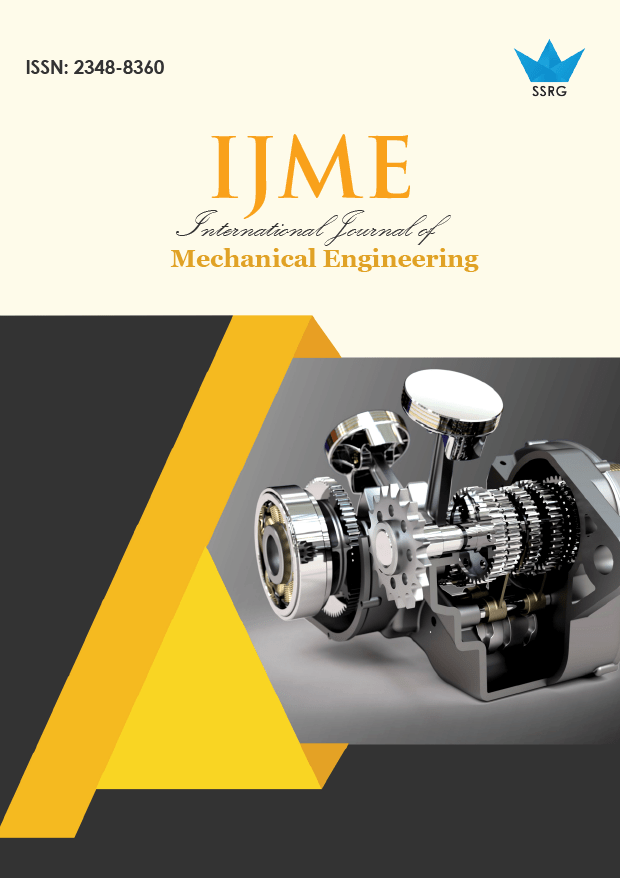Numerical Simulations on Hexa-copter Drone for I-Section and Hollow Square Arm Cross-Sections for PLA-CF and CFRP Materials

| International Journal of Mechanical Engineering |
| © 2025 by SSRG - IJME Journal |
| Volume 12 Issue 1 |
| Year of Publication : 2025 |
| Authors : Mohammad Abdul Fazal, A. Rajasekhar, R. Rajendra |
How to Cite?
Mohammad Abdul Fazal, A. Rajasekhar, R. Rajendra, "Numerical Simulations on Hexa-copter Drone for I-Section and Hollow Square Arm Cross-Sections for PLA-CF and CFRP Materials," SSRG International Journal of Mechanical Engineering, vol. 12, no. 1, pp. 49-58, 2025. Crossref, https://doi.org/10.14445/23488360/IJME-V12I1P106
Abstract:
Unmanned aerial vehicles (UAVs) with rotary wings, or hexacopters, have a wide range of possible uses in strategic, industrial, medical and defense settings. The design optimization of UAVs is a crucial task that significantly affects the application possibilities due to the tradeoff between flight duration and payload capacity. The core body frame is one of the structural components that make up the majority of the weight of a standard hexacopter. The present study on selecting a hexacopter drone proposed the best cross-section and material for static deformation and stress-induced for two different materials (PLA-CF and CFRP) and two different cross-sections of the arm (I and Hollow square). Dimensions are taken initially from the literature survey. Simulations are done using ANSYS for the literature drone and proposed drone. Topological optimization was also done on the drone arm for different cross-sections and different materials. Considering structural flexibility and stiffness as objective functions for selecting the best drone decision-making through a weighted decision matrix was adopted.
Keywords:
UAV, Hexacopters, Static analysis, Topological optimization, CFRP
References:
[1] Sagar Nvss et al., “Design and Development of Unibody Quadcopter Structure Using Optimization and Additive Manufacturing Techniques,” Designs, vol. 6, no. 1, pp. 1-25, 2022.
[CrossRef] [Google Scholar] [Publisher Link]
[2] Sagar Shelare et al., “A Payload Based Detail Study on Design and Simulation of Hexa-Copter Drone,” International Journal on Interactive Design and Manufacturing, vol. 18, pp. 2675-2692, 2024.
[CrossRef] [Google Scholar] [Publisher Link]
[3] Remote Controlled Air Vehicle Based Sanitizing System with Payload Carrier, Wipo, 2021. [Online]. Available: https://patentscope.wipo.int/search/en/detail.jsf?docId=IN335044887&_cid=P21-LCSPDH-44778-1
[4] C. Huang Shen et al., “Theoretical Development and Study of Takeoff Constraint Thrust Equation for A Drone,” 2017 IEEE 15th Student Conference on Research and Development (SCOReD), Wilayah Persekutuan, Putrajaya, Malaysia, pp. 18-22, 2017.
[CrossRef] [Google Scholar] [Publisher Link]
[5] J. Verbeke et al., “The Design and Construction of a High Endurance Hexa-Copter Suited for Narrow Corridors,” 2014 International Conference on Unmanned Aircraft Systems (ICUAS), Orlando, FL, USA, pp. 543-551, 2014.
[CrossRef] [Google Scholar] [Publisher Link]
[6] Jozef Novotňák et al., “Quadcopter Modeling Using a System for UAV Parameters Measurement,” Drones, vol. 8, no. 7, pp. 1-18, 2024.
[CrossRef] [Google Scholar] [Publisher Link]
[7] Yongjie Zhang et al., “A Simplified FE Modelling Strategy for the Drop Process Simulation Analysis of Light and Small Drone,” Aerospace, vol. 8, no. 12, pp. 1-33, 2021.
[CrossRef] [Google Scholar] [Publisher Link]
[8] Endrowednes Kuantama, Dan Craciun, and Radu Tarca, “Quadcopter Body Frame Model and Analysis,” Annals Of The University of Oradea Fascicle of Management and Technological Engineering, vol. 25, no. 1, pp. 71-74, 2016.
[Google Scholar] [Publisher Link]
[9] W. Grodzki, and A. Łukaszewicz, “Design and Manufacture of Unmanned Aerial Vehicles (UAV) Wing Structure Using Composite Materials,” Meterials Science and Engineering Technology, vol. 46, no. 3, pp. 269-278, 2015.
[CrossRef] [Google Scholar] [Publisher Link]
[10] Vishank Bhatia et al., “Design Optimisation and Analysis of a Quadrotor Arm Using Finite Element Method,” Applied Mechanics and Materials, vol. 664, pp. 371-375, 2014.
[CrossRef] [Google Scholar] [Publisher Link]
[11] Syahril Amir Mohd, Kok Beng Gan, and Ahmad Kamal Ariffin Mohd Ihsan, “Development of Medical Drone for Blood Product Delivery: A Technical Assessment,” International Journal of Online & Biomedical Engineering, vol. 17, no. 9, pp. 1-14, 2021.
[CrossRef] [Google Scholar] [Publisher Link]
[12] M. Elsamanty et al., “Methodology for Identifying Quadrotor Parameters, Attitude Estimation and Control,” 2013 IEEE/ASME International Conference on Advanced Intelligent Mechatronics, Wollongong, NSW, Australia, pp. 1343-1348, 2013.
[CrossRef] [Google Scholar] [Publisher Link]
[13] Osman Öztürk, “Parametric Optimization of Structural Frame Design for High Payload Hexacopter,” Black Sea Journal of Engineering and Science, vol. 7, no. 5, pp. 854-865, 2024.
[CrossRef] [Google Scholar] [Publisher Link]
[14] M. Hassanalian, and A. Abdelkef, “Classifications, Applications, and Design Challenges of Drones: A Review,” Progress in Aerospace Sciences, vol. 91, pp. 99-131, 2017.
[CrossRef] [Google Scholar] [Publisher Link]
[15] Anouar El Magri et al., “Mechanical Properties of CF-Reinforced PLA Parts Manufactured by Fused Deposition Modeling,” Journal of Thermoplastic Composite Materials, vol. 34, no. 5, pp. 581-595, 2021.
[CrossRef] [Google Scholar] [Publisher Link]

 10.14445/23488360/IJME-V12I1P106
10.14445/23488360/IJME-V12I1P106